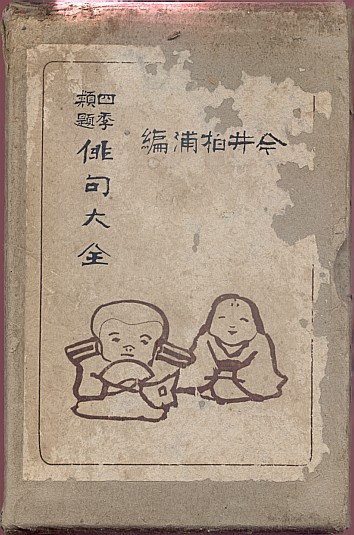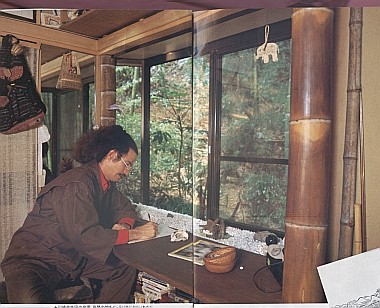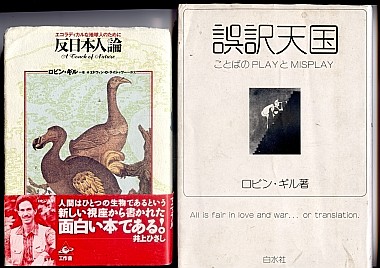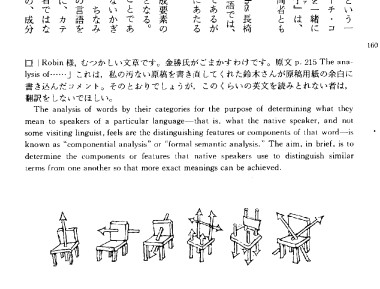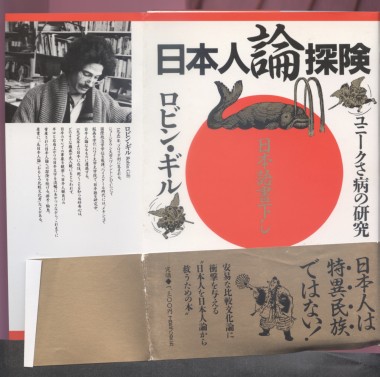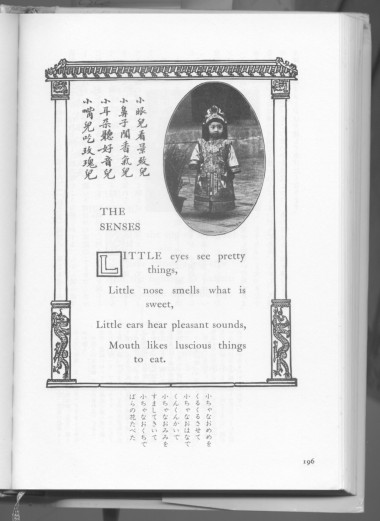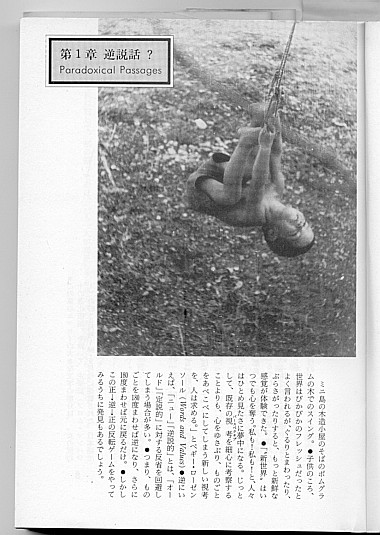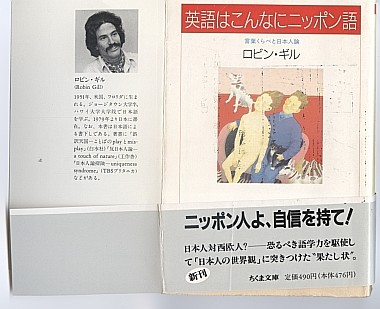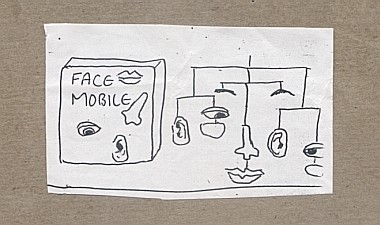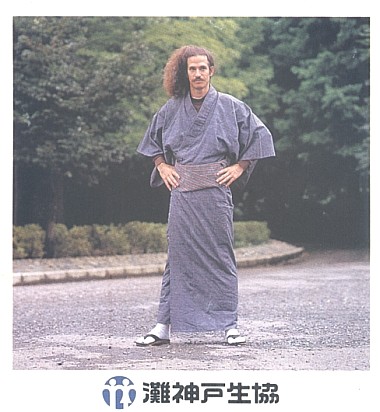|
|
Illustrations of Books
by Robin (d.) Gill published in Japan/ese between 1984 and 1991. There are six or seven, depending upon whether a reprint with 10% added and a brand new name is considered another book. Yet, as far as I know, not a single image of my books or of me have ever been reproduced in English language media. We call this a small world, but despite my fame in Japan, I could not even open a checking account when I returned to the USA in 1998 to find family members who worried that I would be thought "homeless" if I didn't wear a suit . . . Suddenly, I was not only anonymous again but, as a poor person, not treated with the respect I had come to expect. The USA had turned into the Mammon it had long been called! Even the supposedly environmentally conscious children of the 60's bought SUV's by the droves and worshipped the stock market while giving lip service to creativity. Where we once stopped the SST for the best of reasons, now people fly about as if they have the right to waste all the resources they please, simply because they are rich (though they might complain about poverty, they would be rich if they traveled less). Not only did the "air-conditioned nightmare" return with a vengeance, but now it was no longer innocent. My nation had become the embodiment of hypocrisy. Pardon the digression. Here is something about the books for which I was known in a country that, for all its faults, truly respects intellectual work and those who do it. (The book on the left is not by me. It is a wonderful pre-WWII haiku almanac I am lucky to own. The amateurish hand-written look of the cover is a splendid contrast with the masterful selection of haiku within.) |
|
All my books were hand-written. Since I hated typing, I pretty much had to write my books in Japanese rather than in English. (Today, young Japanese must submit typed=computered manuscripts, but old writers are permitted their handwriting.) My 10 by 12 foot room in Japan was surrounded on two-sides by bamboo. I used the bamboo (cut for coming up too close to the apartment) for decoration. The white line by the joint means it was a yearling bamboo. Believe it or not I shared this tiny bedroom/living-room/study with a woman for almost 5 of the 10 years I stayed. And we had an average of 3-5 cats coming in and out through the open window.
|
|
|
|
The book on the left is Han-Nihonjinron, or Anti-Japanology. The subtitle is "a touch of nature." It challenges stereotypes about national character, with a focus on environmental reductionism. The same year my book was published, Kousakusha also published James Lovelock's groundbreaking Gaia. It is now in its fourth or fifth printing. The book on the right is Goyaku Tengoku, or Mistranslation Paradaise. I was amazed that this rather difficult book also went 4 (or 5?) printings and wonder if the soothing blue of the obi (belt with blurbs) played a role in this! The cover picture is a copy of a large etching I made at age 20. |
|
For both of these books, I was able to convince the publisher to allow the use of footnotes. The footnote to the right is from Mistranslation Paradaise and includes two sentences from Peter Farb's Word Play that gave the translator trouble, and my illustration that went along with a passage in Word Play where the chair and spear were mentioned as part of the same category in an African culture (both were symbols of authority). I had a lot of fun making this book, for I had the cooperation of a marvelous editor, Tsurugaya Shinichi, who is now the editor of his own publishing house, editions Papyrus. How many major publishers in the world would permit the freedom I was given? |
|
|
|
This page comes from the chapter on Men and Dresses in Anti-Japanology. If you have not read Pflugel (mentioned in the body) on the Psychology of Clothing, do! He argued that men's clothing showed less variation than that of women because women are by nature social and capable of braving convention, where men are "timid creatures" that dare not make waves. Of course, this is partly because men were (and still are) the slaves of their employers. Where women only needed to fear sartorial regulation and the displeasure of their husbands, men had to obey the rules or get fired and lose everything. Women won back trousers and today in the West are free to wear pretty much what they please, where men only wear a narrow range of dress. What does this have to do with Japanology? Well, if we look historically, we can see that robes vs trousers is not an East-West but a traditional-modern difference. And, if we forget about stereotypes and think logically, we need to literally Redress our world. |
|
The book on the right is the one that might have been a best-seller had it only been given a good title. I mention cetaceans in it. The obi catch-phrase reads "The Japanese are not a special people!" The gold and red on the cover were beautiful but the cover was just too crowded to draw in the reader and this book went only one printing. This was my only general anti-japanology=stereotype book. |
|
|
|
This is a page from a reproduction of I.T. Headland's turn of the century Chinese Mother Goose. The Japanese translation below is by Hoshino Takashi. I wrote an essay for each poem and worked with Hoshino to expand his annotation for the general reader. I wanted Hoshino and Headland's name with mine on the front cover, but the publisher thought that would be confusing and (against my wishes) used only my (better known) name. I feel that Chinese lullabies reflect a greater love for children than found in those of the West, unless we include later addtions by individual authors (Christina Rossetti comes to mind). I have about 30 small books-to-be of Chinese lullabies+essays which I hope to complete after getting IPOOH on its way and if/when I have the money to hire Hoshino (who is one fun scholar!) to help fill them out. |
|
If only the cover for Kora!mu (title puns on "Hey!" and "Column") were as good as this chapter heading, this collection of my essays (from 1983-8) published by Hakusuisha might have done much better. This swing was in our front yard on Key Biscayne. A few years after the photo was taken, I saw a rattlesnake under the swing which one of my sisters was on, and stabbed it with my home-made spear! Issa's haiku about a cat drawn up two or three feet into the air by a butterfly and a James Jone's passage of an old person returning a sneeze for a proferred tissue were two of the examples of paradoxical -- seemingly inverse -- passages given in the lead essay. |
|
|
|
This book was belly-up with a bad name until republished as a pocket-book with a better name (English is That Japanese). But only 21,000 copies later, it died again and the publisher destroyed the last 300 copies without even telling me! This book has many fans -- I often get requests for it -- and as soon as my new writing on haiku gains me more attention in Japan, it will surely be republished, if not by Chikuma, by me! |
|
To the right the back cover of a magazine in which I was the feature article. My hair was supposed to stand straight up over my head where it did the most good as a parasol. I never could find a good sleeve for it as that was not a fashion among men or women in Japan (or anywhere, I guess!). The kimono was found in a used clothing shop. Writing was but my most successful activity. Below is one of scores of ideas for miniature mobiles I hoped to convince someone to produce. Anyone out there who wants to make a go of it?
|
|
